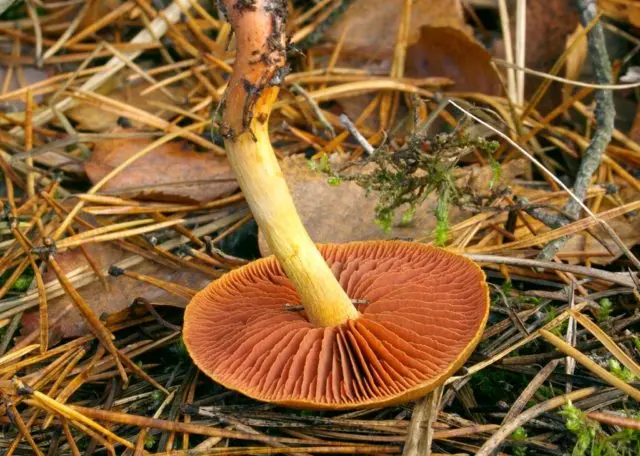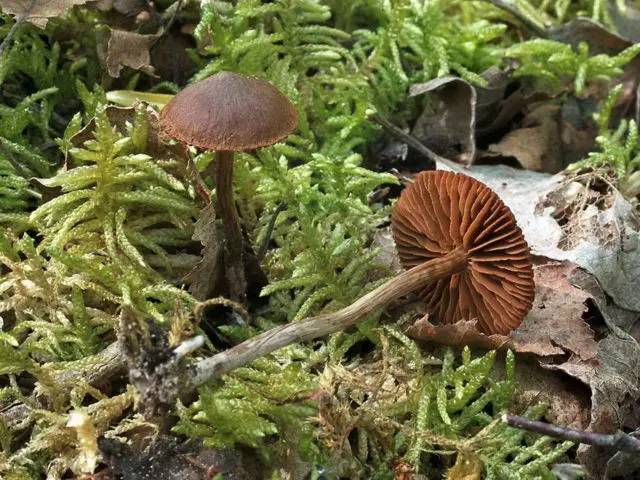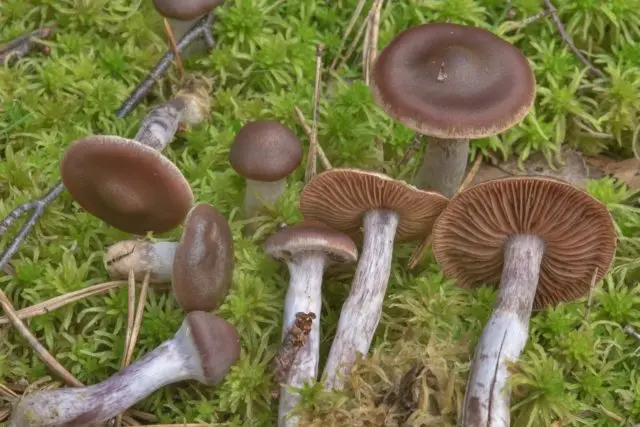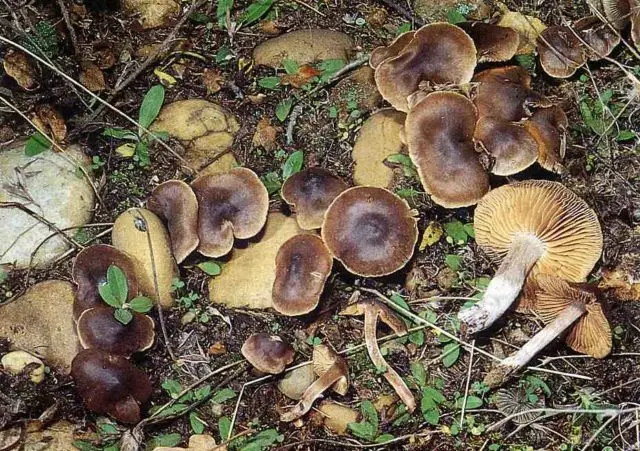Contents
Bright red cobweb (Cortinarius erythrinus) is an agaric fungus belonging to the Spider Web family and the Spider Web genus. It was first described by the Swedish botanist, the founder of the science of mycology, Elias Fries in 1838. Its other scientific name is Agaricus caesius, from 1818.
Description of the bright red cobweb
The bright red cobweb consists of a hat and a relatively long, thin stem. If the mushrooms have grown through a thick layer of moss, the stems can be three times the diameter of the caps, remaining no more than 0,7 cm thick.

The bright red cobweb often hides in thickets of moss, exposing only the tops to the surface.
Cap Description
Only the fruiting bodies that have appeared have rounded bell-shaped caps. As they grow, they straighten out, first acquiring the correct spherical or umbrella shape, then becoming almost straight, outstretched. In the center of most specimens, a pointed tubercle and a cup-shaped depression are clearly visible. Margins at first turned up, then become slightly directed downwards, and in overgrowths they may rise, showing a serrated edge of the hymenophore. The diameter is usually from 0,8 to 2,5 cm, very rare specimens grow up to 3-5 cm.
The color of young specimens is uneven, in the center of the cap it is noticeably darker, the edges are light. From rich chocolate to pinkish-brown, pale chestnut and beige shades. In overgrown specimens, the color becomes uniformly dark, black chocolate or purple chestnut. The surface is smooth, matte, slightly velvety, with clearly visible radial fibers. In overgrowths it is covered with small wrinkles, shiny in bright light and in wet weather.
Hymenophore plates sparse, serrated-incremented, of different lengths. Quite wide and uneven. The color can vary from cream-buff, dirty red and milky coffee to dark brown with reddish and dove shades. Reddish-purple and lilac spots can often be found. The spore powder has a brownish color. The pulp is light brown, dirty purple or reddish chocolate, thin, elastic.

Hymenophore plates have unevenly serrated, curved edges
Description of the leg
The bright red cobweb has a cylindrical leg, hollow, often curved and sinuous, with distinct longitudinal grooves-fibers. The surface is matte, slightly damp. The color is uneven, with spots and longitudinal lines, from creamy yellowish and pale beige to pink-brown and purple-chestnut, the hat may have a purple-brown hue. Its length is from 1,3 to 4 cm, individual specimens reach 6-7 cm, the thickness varies from 0,3 to 0,7 cm.

Most of the leg is covered with a grayish-silver fluff
Where and how to grow
The bright red cobweb appears in the forests early, in May, as soon as the earth warms up. Mushrooms bear fruit until the end of June. Rarely give a second harvest, which falls on the beginning-mid-autumn. Distributed in temperate and subtropical climate zones, in the central and southern regions of Our Country, in Europe.
They prefer damp places, grass thickets and moss tussocks. They grow mainly in deciduous forests, next to birches, lindens and oaks. It can also be found in spruce forests. They grow in small, sparsely located groups. This fungus is rare.
Is the mushroom edible or not?
The bright red cobweb has been little studied due to its miniature size and extremely low nutritional value. For mushroom pickers, it is of no interest. There is no publicly available verified data on its chemical composition and effects on the human body.
Twins and their differences
The bright red cobweb is extremely similar to some types of related mushrooms.
- Cobweb brilliant (Cortinarius evernius). Inedible, non-toxic. It is distinguished by a delicate color of hats, the color of milk chocolate and encircling tubercles on the legs.

The legs are noticeably thicker, fleshy, abundantly covered with white fluff
- Cobweb chestnut. Conditionally edible. This is an autumn mushroom that bears fruit in August-September in deciduous forests and wet spruce forests.Comment! Previously, this type of cobweb was considered identical to bright red. Studies at the cellular level have revealed the differences between these types of fungi.

Caps of fruiting bodies are reddish-brown or sandy-brown, hymenophore is distinctly yellowish
Conclusion
The bright red cobweb is a small, little-studied agaric fungus. It occurs very rarely in deciduous and mixed birch-spruce forests, in grass and among mosses. Likes wet places. Grows in small groups from May to June. There is no exact data on its edibility.











